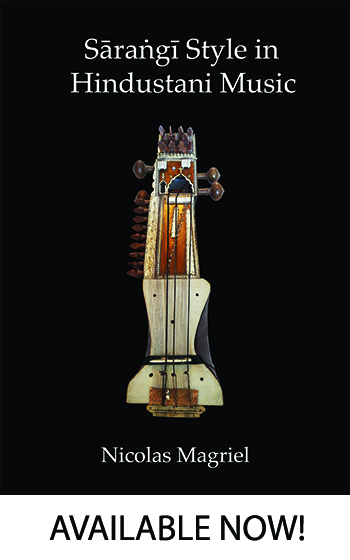I began learning sarangi in the end of 1970 from Ustad Sabri Khan in Delhi. I went on to learn from the great Pandit Gopal Mishra and his brother Pandit Hanuman Prasad Mishra of Banaras. Other cherished teachers have been Ustad Abdul Latif Khan in Bhopal, Ustad Mohammed Ali Khan and Ustad Ghulam Sabir Qadri in Delhi, Pandit Baccha Lal Mishra and Ustad Zakan Khan in Banares. My main teachers of vocal music have been Pandit Dilip Chandra Vedi in Delhii, and Ustad Aslam Khan and Pandit Batuk Dewanji in Bombay. Fot detailed information about my talim and my musical journey please see the Nicolas Magriel page, accessible from the Home page of this site.
I have decided to add this page recently, and will gradually include film clips of my performances on TV during the 1980s and other old films which are now buried elsewhere on this site: (in Other Gems: Miscellaneous Videos).
To begin with, my most recent performance—on March 2nd, 2016 at the Nehru Centre, the cultural wing of the Indian high Commission, in London. I was accompanied by my good friend Jhalib Millar, a student of Ustad All Rakha Khan, on tabla.
To emphasise that sarangi usually plays vocal music, I introduced each rag with the poetry of the bandishes which I played. The first three videos below have all the introductions and tuning omitted. Thiese are followed by the same three videos with my talking and tuning included.
Unfortunately the tambura drone was far too loud—I'm sorry about this! It was somewhat quieter on the second and third pieces.
I began with rag Maru Bihag. I played two khayal compositions, learnt from Pandit Bhimsen Joshi: the famous "rasiya ho" in vilambit ektal and "tarapat rain din" in drut tintal:
The next piece was rag Vediki Lalit, a rag which was invented by Dilip Chandra Vedi in 1934 when he performed it at the All India Music Conference on the same stage as other stalwarts such as Ustad Faiyaz Khan and Pandit Om Karnath Thakur. Two compositions "joban jaat" adapted to vilambit tintal and "nainavaa ki tir" in drut tintal. This item had more "instrumental elements" such as tabla improvisations in the vilambit section and ati-drut jhala as the conclusion.
The performance concluded with a purab ang-style bol banao thumri in Mishra Khamaj: "mad he bhare tore nain" as learnt from Padmavibhushan Girija Devi:
The following links will show you the same three videos including all my talking (mainly the poetry of the bandishes) and tuning:
Maru Bihag, Vediki Lalit, Mishra Khamaj thumri
My ancient history
Nicolas Magriel plays Yaman in a BBC extravaganza hosted by Ustad Imrat Khan in 1981, the famous bandish by Ustad Faiyaz Khan, "main vaari vaari jaa":
And another relic of my playing from the 1980's, naive but earnest. First rag Bhimpalasi—I think from 1982 or 1983:
And then rag Lalit from 1984:
Nicolas Magriel and Giani Richizzi: sarangi and vichitra vina: rag Bageshri, Assisi, Italy 1993
Nicolas Magriel and Giani Richizzi: sarangi and vichitra vina: rag Lalit, Assisi, Italy 1993
A Life with Sarangi, a documentary by Rolf Killius:
The next item is my performance at the book launch for Sarangi Style in Hindustani Music at the School of Oriental and African Studies, University of London in February 2023. An underlying theme of the book is the relationship between vocal music and sarangi music. In this performance I demonstrated how the sarangi interprets the nuances of vocal music especially the many ways of sliding to and between the notes and the many ways of shaking the notes. Vilambit, madhya and drut alap in dhrupad nom-tom style with some more florid khayal elements incorporated is followed briefly by the khayal bandish "kaun karata tori binati piyaravaa'" Jane Fowler provides the lovely tambura accompaniment.
I never did this before—singing and playing together in public—well I hardly ever did it at home except when teaching—so it was a new experience. Ijaazat dijiyegaa!
Film Music
Some excerpts from my sarangi playing in the Jewel in the Crown, 1984. My sarangi was utilised for the most macabre scenes in the series. All excerpts employ a loosely interpreted Shri Rag.
1) In conversation withwith Peggy Ashcroft, Geraldine James recalls a scorpion's self-immolation in a ring of fire:
2) Next we have Wendy Morgan, a young mother's attempted murder of her baby—also in a ring of fire:
3) Charles Dance discovers a disillusioned officer's attempted suicide in the bathtub.



